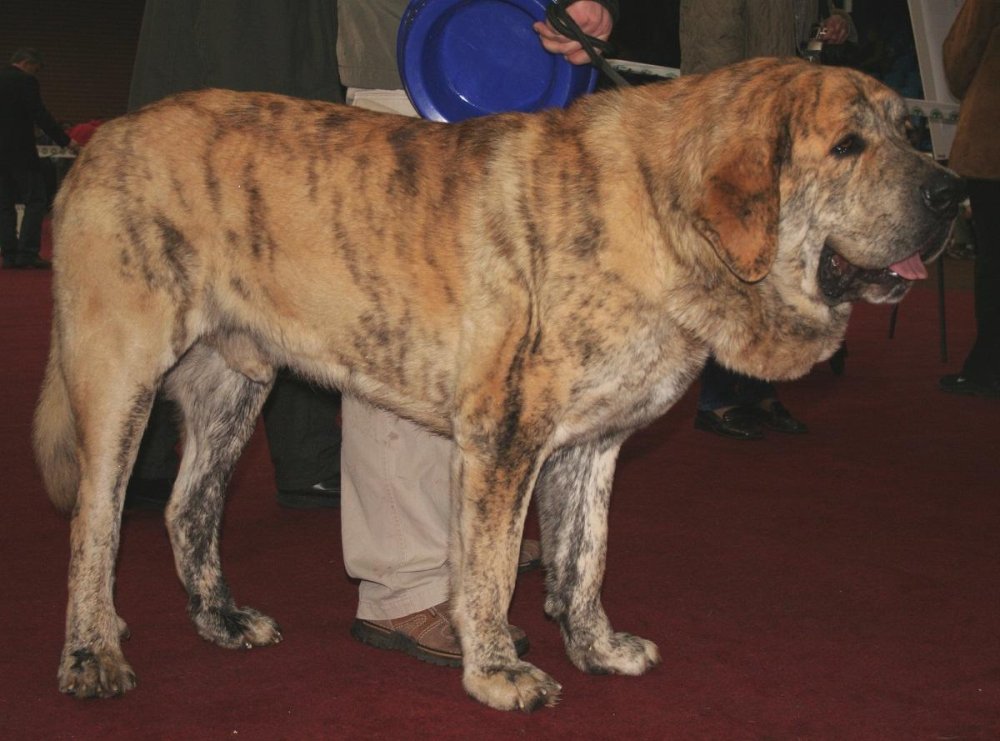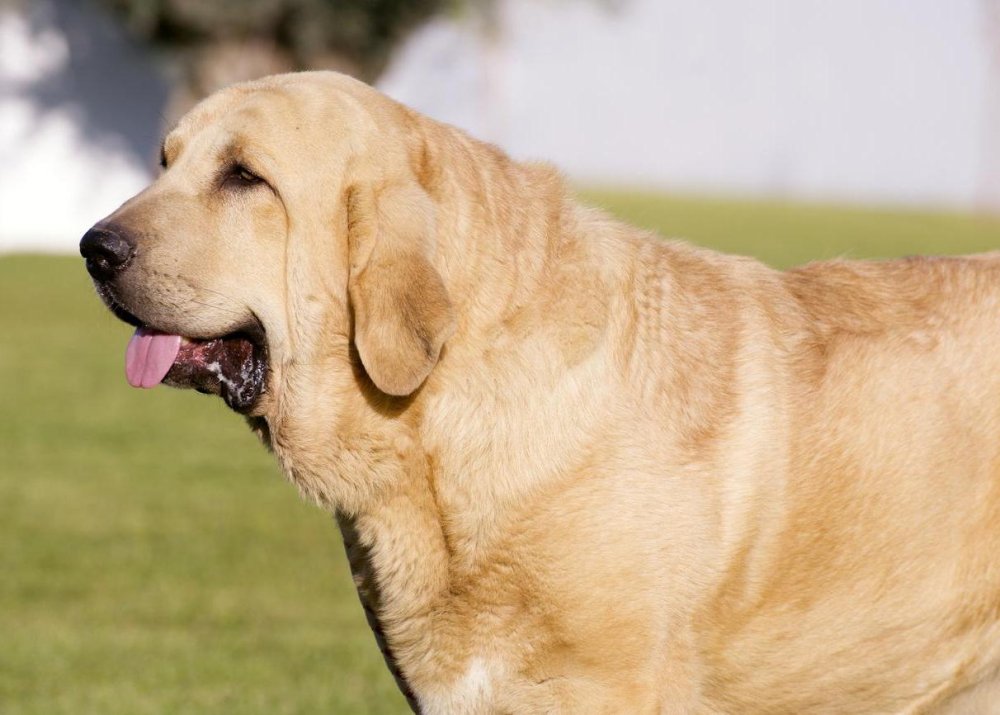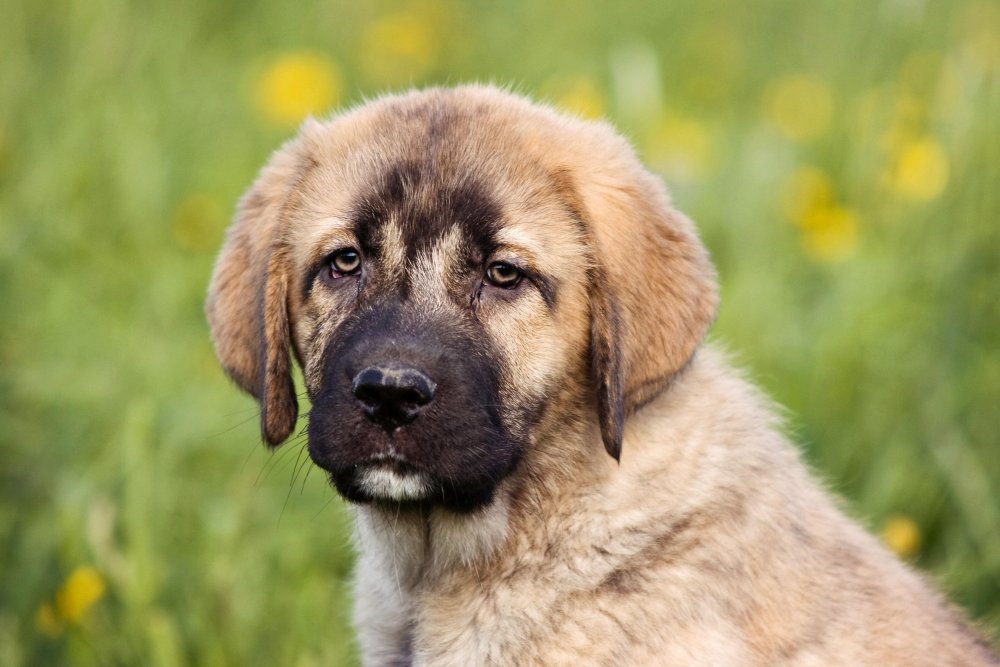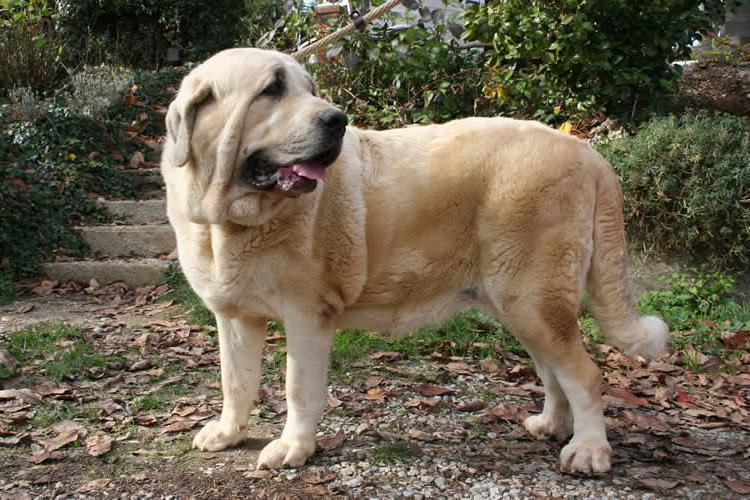- Breed Category: Working Group
- Country of Origin: Spain
- Average Height: Males 70-85 cm, Females 65-80 cm
- Average Weight: Males 50-70 kg, Females 40-60 kg
- Average Life Span: 10-12 years
- Grooming Requirements: Moderate, regular brushing needed
- Exercise Requirements: Moderate, daily walks recommended
- Coat Type: Dense, medium-length
- Coat Color Variations: Fawn, brindle, black, red
- Shedding Level: Moderate to high
- Ear Type: Droopy, triangular
- Tail Type: Long, thick
- Temperament: Loyal, protective, calm
- Intelligence Level: High
- Barking Tendency: Low to moderate
- Compatibility with Children: Good, with supervision
- Compatibility with Other Pets: Generally good, early socialisation helps
- Training Ease: Moderate, requires consistent training
- Common Health Issues: Hip dysplasia, bloat
- Dietary Needs: High-quality, balanced diet
- Energy Level: Moderate
- Drooling Tendency: High
- Sensitivity to Weather: Tolerates cold, sensitive to heat
- Overall Maintenance Level: Moderate
- Original Purpose: Livestock guardian
- Year of Recognition by Kennel Clubs: 1954
- Apartment Friendly: Not ideal, needs space
- Best Suited For: Rural or suburban homes
- Cost of Ownership: Moderate to high
- Unique Traits: Strong protective instincts
- Cultural Significance: Symbol of Spanish pastoral life
Imagine a dog that’s not just a guardian but a gentle giant with a heart as big as its paws. Meet the Spanish Mastiff. This breed is known for its impressive size and calm demeanour, making it a unique addition to any family. In this article, we’ll explore the Spanish Mastiff’s characteristics, delve into its rich history, and offer insights into its care.
The Spanish Mastiff has roots that trace back to ancient times, believed to have accompanied shepherds in Spain for centuries. Originally bred to protect livestock from predators, these dogs have a storied past that highlights their loyalty and strength. Understanding their history helps us appreciate their role today as both protectors and companions.
Early Development and Historical Significance

Early Development of the Breed
The Spanish Mastiff’s journey began in the rugged landscapes of Spain, where it was developed to meet the needs of shepherds. These dogs were bred for their size and strength, essential traits for protecting flocks from wolves and other predators. Over time, their role as guardians became deeply ingrained in their nature, shaping them into the formidable yet gentle giants we know today.
Role in Spanish Livestock Protection
In the harsh terrains of Spain, livestock protection was no small task. The Spanish Mastiff excelled in this role, using its imposing presence to deter threats. Their loyalty and courage made them indispensable to shepherds, ensuring the safety of valuable livestock. This protective instinct remains a defining characteristic of the breed.
Key Historical Figures and Regions
The breed’s development is closely tied to regions like León and Extremadura, where shepherding was a way of life. Historical figures, including influential breeders and shepherds, played a crucial role in refining the breed’s traits. Their efforts ensured the Spanish Mastiff’s survival and prominence in Spanish culture.
Physical Characteristics
With a massive frame and a thick, weather-resistant coat, the Spanish Mastiff is built for endurance. Their large, expressive eyes and gentle expression contrast with their powerful build, creating a unique blend of strength and serenity. These physical traits not only serve practical purposes but also contribute to their majestic appearance.
Appearance and Unique Physical Traits
The Spanish Mastiff is a sight to behold, with its massive size and commanding presence. Standing tall, these dogs can weigh anywhere from 50 to 70 kilograms, making them one of the largest breeds around. Their coat is thick and dense, perfect for withstanding harsh weather. It comes in a variety of colours, including fawn, brindle, and black, often with distinctive markings that add to their majestic look.
One of the most striking features of the Spanish Mastiff is its large, imposing stature. Despite their size, they carry themselves with a calm dignity. Their broad head and deep-set eyes give them a wise and gentle expression, while their powerful build speaks to their strength and endurance.
Temperament and Behaviour
Don’t let their size fool you; Spanish Mastiffs are known for their gentle and calm temperament. They are incredibly loyal and protective, making them excellent family companions. While they are naturally wary of strangers, they are not aggressive without reason. Their patience and intelligence make them easy to train, though they do require consistent guidance. These dogs are happiest when they have a job to do, whether it’s guarding the home or simply being a loving companion.
Personality Traits and Family Suitability

Typical Personality Traits
Spanish Mastiffs are renowned for their loyalty and protectiveness. These dogs are calm and composed, making them reliable companions. Their natural instinct to guard is balanced by a gentle nature, especially with their family. They are not just protectors but also affectionate members of the household.
Suitability as a Family Pet and Livestock Guardian
As family pets, Spanish Mastiffs are exceptional. Their protective instincts extend to all family members, ensuring a safe environment. They are equally adept at guarding livestock, a role they have fulfilled for centuries. Their size and strength make them formidable guardians, while their calm demeanour ensures they are not overly aggressive.
Interaction with Children and Other Animals
Spanish Mastiffs are generally good with children, displaying patience and gentleness. They tend to be tolerant and protective, making them suitable for families with kids. When it comes to other animals, early socialisation is key. With proper introduction, they can coexist peacefully with other pets.
Training and Exercise Needs
Training a Spanish Mastiff requires consistency and patience. They are intelligent and eager to please, but their independent streak means they need firm guidance. Regular exercise is important to keep them healthy and happy, though they are not overly energetic. A daily walk and some playtime will suffice to meet their needs.
Training, Exercise, and Health

Importance of Early Training and Socialisation
Getting a head start on training and socialisation is crucial for the Spanish Mastiff. These gentle giants benefit from early exposure to different environments, people, and animals. This helps them grow into well-rounded adults, reducing the likelihood of behavioural issues. Early training also establishes a strong bond between you and your dog, setting the stage for a harmonious relationship.
Recommended Training Techniques
When it comes to training, consistency is key. Positive reinforcement techniques work wonders with Spanish Mastiffs. They respond well to praise and treats, making them eager learners. Keep sessions short and engaging to maintain their interest. Remember, patience and persistence will yield the best results.
Daily Exercise Requirements and Activities They Enjoy
While not overly energetic, Spanish Mastiffs still need regular exercise to stay healthy. A daily walk and some playtime in a secure area are usually enough. They enjoy activities that engage their minds, like puzzle toys or basic obedience games. These activities not only keep them fit but also mentally stimulated.
Health and Lifespan
Spanish Mastiffs are generally healthy dogs, but like all breeds, they can be prone to certain health issues. Regular vet check-ups and a balanced diet are essential for maintaining their well-being. With proper care, they typically enjoy a lifespan of 10 to 12 years, providing many years of companionship.
Health and Care for the Spanish Mastiff

Common Health Issues
Spanish Mastiffs, like many large breeds, can face health challenges such as hip dysplasia and bloat. Regular vet visits are crucial to catch any issues early. Keeping an eye on their weight and ensuring they have a balanced diet can help mitigate these risks.
Average Lifespan and Health Tips
With proper care, these gentle giants can live between 10 to 12 years. To keep them healthy, provide a nutritious diet, regular exercise, and mental stimulation. A daily walk and some playtime are usually enough to keep them fit and happy.
Preventative Care Recommendations
Routine check-ups with the vet are essential. Vaccinations, dental care, and parasite prevention should be part of their regular health regimen. Early detection of potential issues can make a significant difference in their quality of life.
Grooming and Maintenance
Their thick coat requires regular brushing to prevent matting and reduce shedding. Bathing should be occasional, as over-washing can strip natural oils. Regular nail trimming and ear cleaning are also important to maintain their overall health and comfort.
Coat Care and Grooming Routines

Shedding and Seasonal Grooming Tips
The Spanish Mastiff’s thick coat is designed to protect them from harsh weather, but it also means regular grooming is a must. They shed moderately throughout the year, with heavier shedding during seasonal changes. To keep their coat healthy and your home fur-free, brush them at least once a week. During shedding seasons, increase this to a few times a week to manage the extra hair.
Invest in a good quality brush that can handle their dense fur. Regular brushing not only reduces shedding but also helps distribute natural oils, keeping their coat shiny and healthy. Bathing should be occasional, as over-washing can strip these oils. A bath every few months or when they get particularly dirty is usually sufficient.
Diet and Nutrition
A balanced diet is crucial for the Spanish Mastiff’s health and longevity. These large dogs require a diet rich in high-quality protein to support their muscle mass. Look for dog food that lists meat as the first ingredient and avoid fillers like corn and soy. Omega-3 fatty acids are beneficial for their coat and joint health, so consider foods that include fish oil or flaxseed.
Portion control is important to prevent obesity, which can exacerbate joint issues common in large breeds. Divide their daily food intake into two meals to avoid bloat, a serious condition that can affect deep-chested dogs like the Spanish Mastiff. Always provide fresh water and consult your vet for specific dietary recommendations tailored to your dog’s needs.
Nutritional Needs and Feeding Guidelines

Nutritional Needs for Optimal Health
For a Spanish Mastiff, a balanced diet is key to maintaining their health and vitality. These dogs thrive on high-quality protein sources, which support their large muscle mass. Look for dog food where meat is the first ingredient, and steer clear of fillers like corn and soy. Omega-3 fatty acids are also beneficial, promoting a healthy coat and supporting joint health.
Foods to Include and Avoid
Include foods rich in protein and healthy fats, such as chicken, beef, and fish. Foods with added glucosamine and chondroitin can support joint health, which is crucial for large breeds. Avoid foods with artificial preservatives, colours, and flavours, as well as those high in grains and fillers.
Feeding Schedules and Portion Recommendations
Divide their daily food intake into two meals to help prevent bloat, a condition that can affect deep-chested breeds. Portion control is essential to avoid obesity, which can lead to joint problems. Always provide fresh water and consult your vet for specific portion recommendations based on your dog’s age, weight, and activity level.
Fun Facts and Trivia
Did you know that the Spanish Mastiff’s thick coat not only protects them from harsh weather but also helps them blend into the landscape while guarding livestock? This breed’s history as a protector is so ingrained that they often patrol their territory instinctively, even in a family setting. Despite their size, they are known for their gentle nature, making them excellent companions for children.
Interesting Tidbits and Famous Spanish Mastiffs

Interesting Tidbits about the Breed
The Spanish Mastiff is not just a dog; it’s a piece of living history. These dogs have been around for centuries, originally bred to protect livestock from predators like wolves. Their thick coats and massive size were perfect for the rugged Spanish terrain. But did you know that their droopy jowls and loose skin serve a purpose? They help protect against bites during confrontations with predators. It’s fascinating how every part of their anatomy has a function.
Another interesting fact is their unique vocalisation. Spanish Mastiffs have a deep, resonant bark that can be heard from quite a distance. This was particularly useful for shepherds who needed to know their dogs were on the job, even when out of sight.
Famous Spanish Mastiffs in Media or History
While the Spanish Mastiff may not be as famous in movies or TV shows as some other breeds, they have made their mark in history. These dogs have been celebrated in Spanish culture for their role in protecting livestock. In fact, they are often featured in Spanish folklore and stories, symbolising strength and loyalty. Their presence in historical paintings and literature highlights their importance in rural Spanish life.
Final Thoughts

The Spanish Mastiff is a gentle giant with a protective heart. This breed’s rich history and loyal nature make it a remarkable companion. Balancing their size and strength with a calm demeanor, they offer both security and affection to their families. Embracing their unique traits and understanding their needs can lead to a rewarding relationship. Consider welcoming a Spanish Mastiff into your home for a blend of history, loyalty, and companionship.
